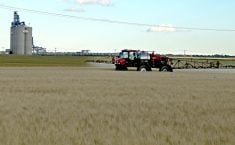John Gehrer’s organic weed management strategy uses technology farmers have employed since the first wheat was domesticated.
He controls weeds by cultivating between the rows without harming the crop.
To enable between-row cultivation, all crops are planted on 22-inch row spacing with an old John Deere corn planter. He has a variety of discs for every kind of seed from hemp to cereals to corn or canola. With Gehrer’s farm located in an area that was once prime sugar beet country, he found an abundance of abandoned 1980-era sugar beet equipment at low prices. And it’s all on 22-inch row spacing.
Read Also

House ag committee to undertake several studies
The House of Commons standing agriculture committee has set its agenda for the coming months. Members began the fall sitting with a two-hour update on international trade
“When beet farmers planted, they made a little furrow between two rows of beets, almost like a plow furrow. That little trench remains all summer. I use a 22-foot wide cultivator that was manufactured with a guide wheel that keeps it in the furrow. As long as the tractor runs straight, the cultivator stays in the furrow all day. Our guidance keeps the tractor straight.
“The cultivator floats on the three-point hitch, three or four inches sideways. It’s very precisely close to the row. So we have 19 inches of cultivation between rows on 22-inch centres.
“A German friend uses a similar system with 20-inch row spacing. He farms 500 hectares, (1,235 acres) all organic and all row cropping. He’s much more disciplined than I am. He hills the soil around the crop, like potato hilling. This puts soil close to the crop and covers small weeds. He adds a cover crop on the last cultivation pass of the season so it has a head start without competing with the main crop.
“This is the goal for our farm also. We will have to improve our cultivation by hilling in the seed row to cover up small weeds and control things like pigweed and millet.”
He said modern between-row systems rely on an expensive electronic eye to keep the cultivator centred. It sees where the rows are, then commands the hydraulic cylinder to move left or right. Gehrer said that technology really isn’t necessary.
“My system works just as well. I’m right now looking for a 40-foot cultivator, but they’re getting to be harder to find. The demand for used inter-row equipment is increasing, likely because of organic and non-GMO farmers.
“That’s why our farm yards look like junk yards. We’re so cheap. We drag in equipment from all over the place. Stuff that other farmers don’t need anymore. There’s not really a lot of new equipment we need. My most expensive item is the cultivator. That cost me $2,200.
“One thing I want to do next is develop a low-disturbance shallow cultivator that serves organic, non-GMO and also zero till farmers. It would have independent depth control on each shank. There’s a need for a machine like that. Of course, buying a brand new piece of equipment might not go over so well with like-minded farmers such as me.”


















